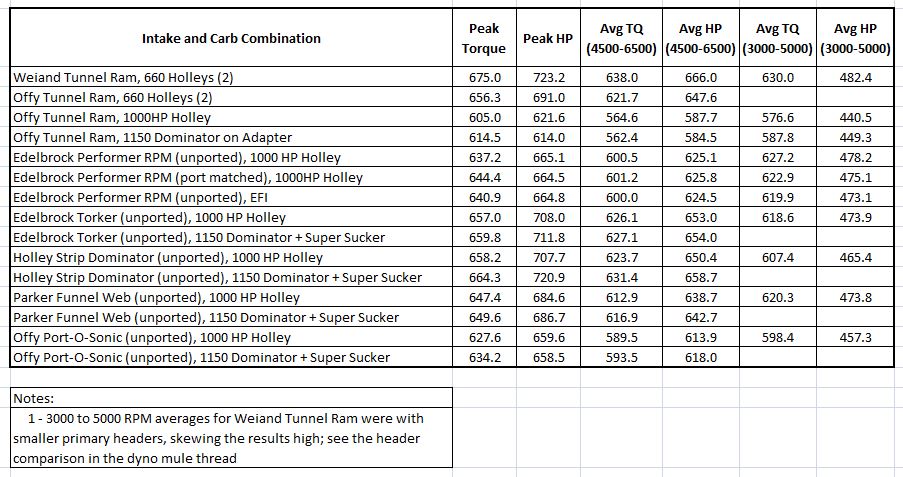Back on the dyno testing today, finally

It was a semi-abbreviated session due to some unexpected problems that were encountered, but in the end we got some very good, and very interesting data. My friend Kevin was over giving me a hand with the testing.
We started off with the Holley Strip Dominator, after I had machined it to fit on the engine so that we still had crankcase vacuum. First couple of runs were with the 1000 HP Holley carb. On the first pull we ran the 3000-5000 RPM test, and got results that I had more or less expected; the engine picked up about 10 HP and 10 lb-ft of torque with the vacuum pump working. Here's the dyno data:

However, when we tried to go into the next pull, the engine ran strong up to 6000 RPM and then started missing badly. This was a surprise; the engine had never behaved like this before. After giving it a good once over in the dyno room, and finding nothing wrong, I decided to hook my laptop up to the MS3-Pro so that I could datalog all the parameters monitored by the MS3-Pro during the dyno pull. We ran the pull again, and sure enough the miss was still there. But when I pulled up the datalog and started looking at some of the ignition parameters, I saw what is called a "sync" loss in the data. This means that the crank sensor signal is being interrupted somehow, and the MS3-Pro kicks out a code that is visible in the datalog, indicating a problem.
We checked the wiring from the MS3-Pro and my electronics box down to the sensor, and everything looked fine. The sensor has been around for a while, and I don't recall its history but I've had it for five years or so. I had a new sensor in my parts department, so I decided to swap with the old sensor and see if that resolved the problem. Sure enough, the problem was solved and the next pull ran cleanly to 6500 RPM. This is the first time I've seen one of those sensors go bad, and it only quit working at high engine speeds. Go figure...
Anyway, the Strip Dominator pull to 6500 RPM was another surprise, and this time a pleasant one. Having the vacuum pump operational made a huge difference for this manifold. The graph below shows the results with and without the vacuum pump:
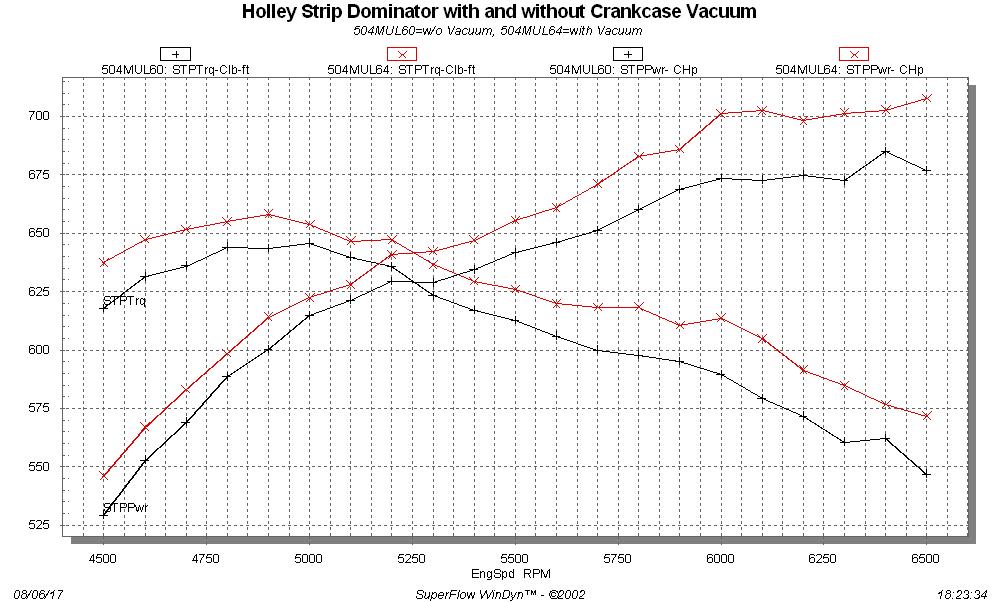
What a difference, and it was nice to see some more 700 HP numbers from this engine. The results were nearly identical to those of the Torker, although the average numbers across the pull showed the Torker to be a hair stronger. But nevertheless, a big improvement for the Strip Dominator. Here is a graph showing the Torker vs. the Strip Dominator, this time on equal footing for crankcase vacuum:

Brent Lykins was kind enough to send me his Super Sucker adapter that would allow bolting a Dominator carb onto an intake designed for a 4150 carb, so the next test was to bolt on the Dominator carb and see what happened. It was clear from looking at the manifold vacuum numbers on the single 4 carbs that the engine wanted more carburetor, and I was hoping with the Super Sucker spacer I'd have better luck with the Dominator carb. I was not disappointed; here is a graph showing the difference between the two carbs on the Strip Dominator intake:
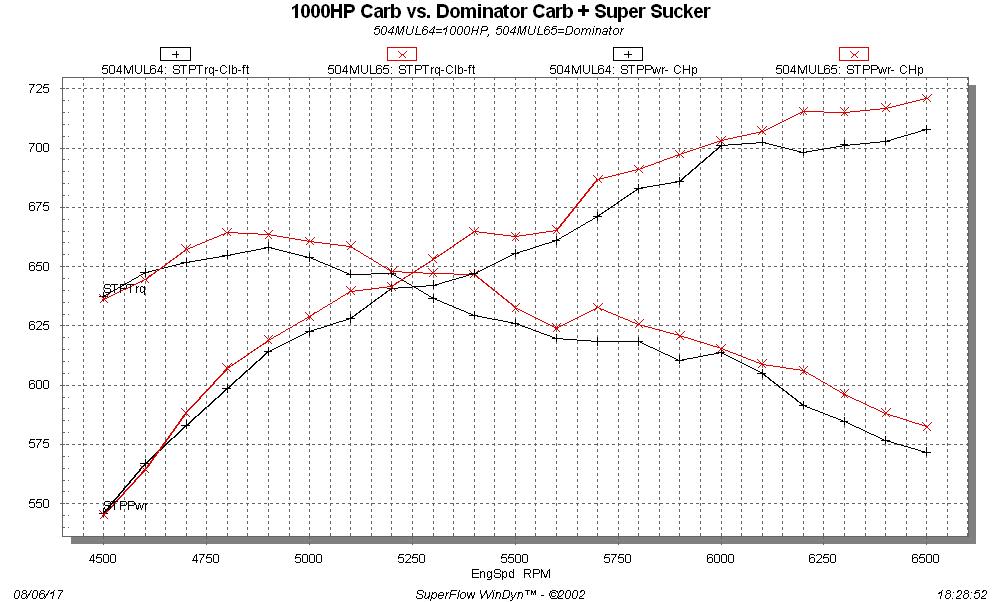
Peak horsepower was nearly as high as the Weiand tunnel ram, and it appears that it might go higher if I wanted to rev the engine a bit more. Overall an excellent performance from the Strip Dominator.
After seeing the Dominator carb's improvement on the Strip Dominator intake, I was anxious to try it out on the Parker Funnel Web. We installed that intake on the dyno, with the Dominator carb and the Super Sucker spacer, and ran the test. The results were disappointing:
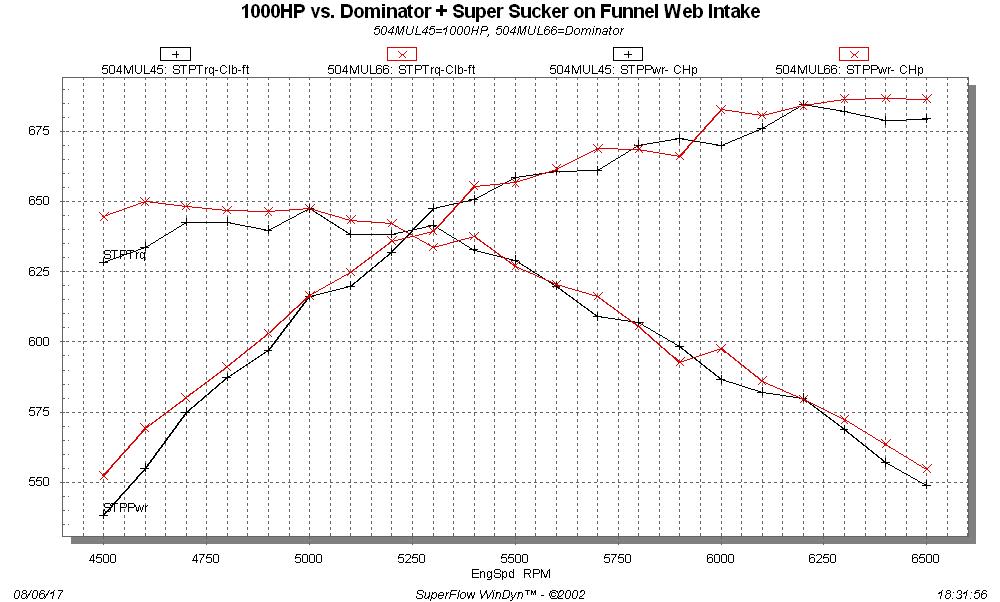
There doesn't seem to be a significant gain from using the Dominator carb on the Funnel Web intake. However, the size of the Funnel Web ports presents a plausible explanation; they are smaller than the ports of the Strip Dominator and Torker, and they may be a bottleneck for this engine. Further, when we were installing this intake, I was surprised to see a significant mismatch at the roof of the ports between the Funnel Web and the intake adapter. Kevin and I had previously checked for that, and not found it, but it appears that it is on one side of the intake only. The left runners line up pretty well with the ports in the intake adapter, but the right runners don't; they are positioned higher, leading to about a 3/16" lip at the roof junction between the Funnel Web and the intake adapter. See the picture below, looking into the plenum:
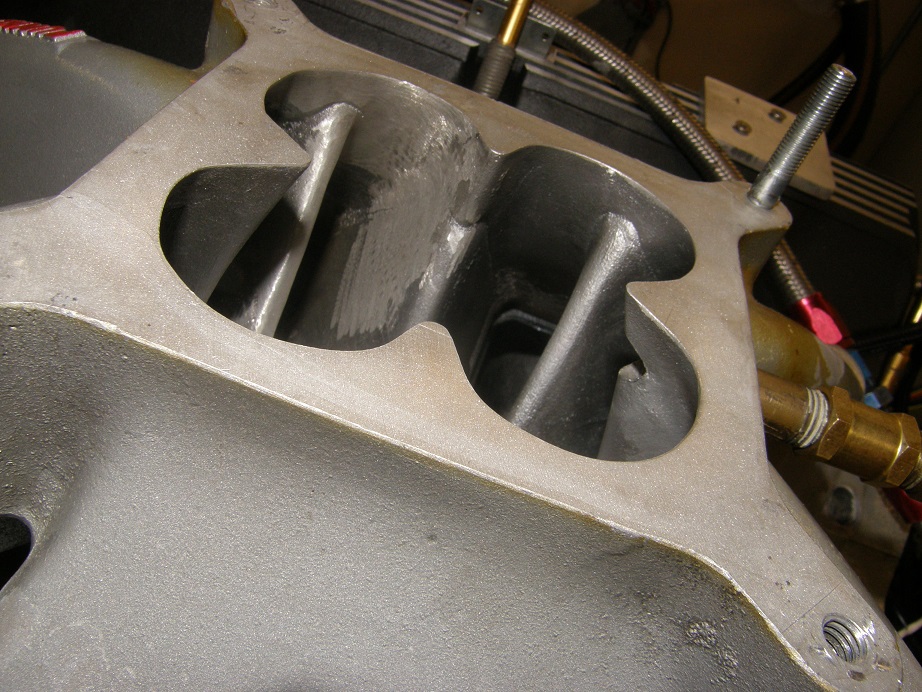
Combined with the smaller port size I think this really handicaps this intake manifold. It would be an interesting test to port the Funnel Web, and the intake adapter, so that the port size is the same as the one on the Strip Dominator or Torker, and have the ports matched up. I'll bet the funnel web would do better.
Next we decided to test the Torker again, but this time with the Dominator carb and Super Sucker adapter. I was anxious to see if this combination would show the same improvement as we had seen with the Strip Dominator. After getting the Funnel Web removed and the Torker installed, I went to start the engine, but got nothing. A look at the electronics box showed that both the crank sensor and cam sensor LEDs were dark, indicating that they weren't getting power. I checked for power to the MS3-Pro, and it was there. It was then I noticed that I had made the cardinal mistake of leaving the ignition switch on while doing the manifold swap. There are still a lot of loose, unconnected wires on the dyno setup, and I figured that I must have shorted one to ground, and blown the internal fuse in the MS3-Pro. I disconnected it from the wiring and took the case apart, and pulled both internal fuses to check them. Sure enough, one was blown.
This would not normally be a problem, but the MS3-Pro uses a rather unique, and very small, fuse that is not available in an auto parts store. I have a little strip of 8 of them around here, but of course finding them was the problem

After hunting around for half an hour I gave up and stole one out of my race car. I replaced the blown fuse, put the case back on the MS3-Pro, and the engine fired right up.
Unfortunately, the Torker did not respond to the Dominator carb as well as the Strip Dominator had. Here's a graph showing comparison between the two carbs on the Torker:
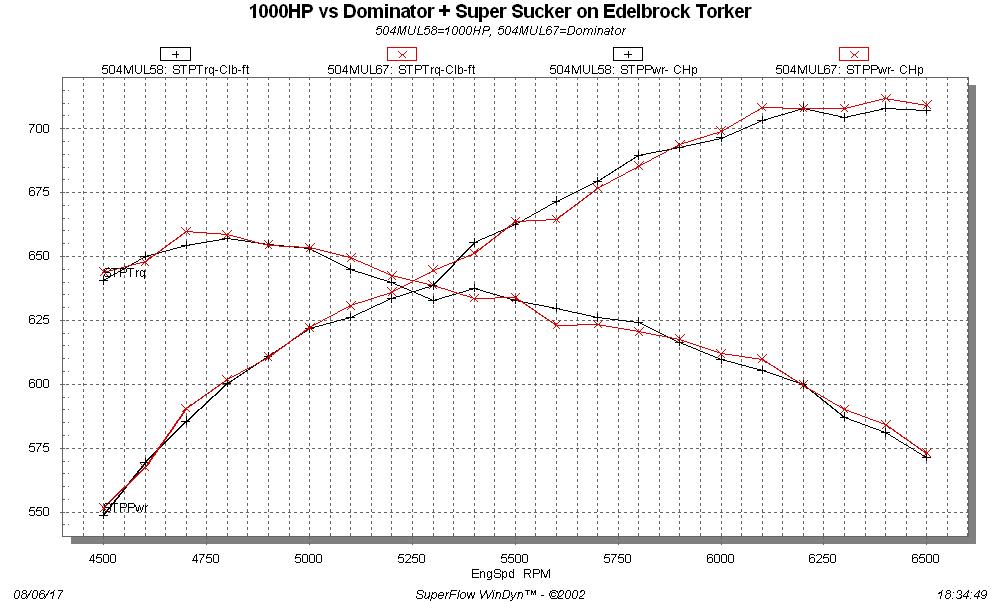
There was a slight improvement, but nothing like what we saw with the Strip Dominator. Its a little baffling to me, because with the Dominator carb the manifold vacuum at the high engine speeds was down significantly from the 1000HP. So, the engine was getting more air. But for whatever reason, that didn't translate into any significant horsepower gain. Go figure...
The last manifold we tested today was Kevin's Offy Port-O-Sonic. This thing has rather small ports, and we didn't have high hopes for it at all, but it provided another data point for comparison's sake. We tested it first with the Dominator carb and Super Sucker; here's a picture of it on the engine:

As expected, the results were a little underwhelming. We ran again with the 1000HP carb, and for sure the manifold liked the Dominator carb setup better, but neither carb gave particularly good results. The graph below shows a comparison of the two carbs on this intake:
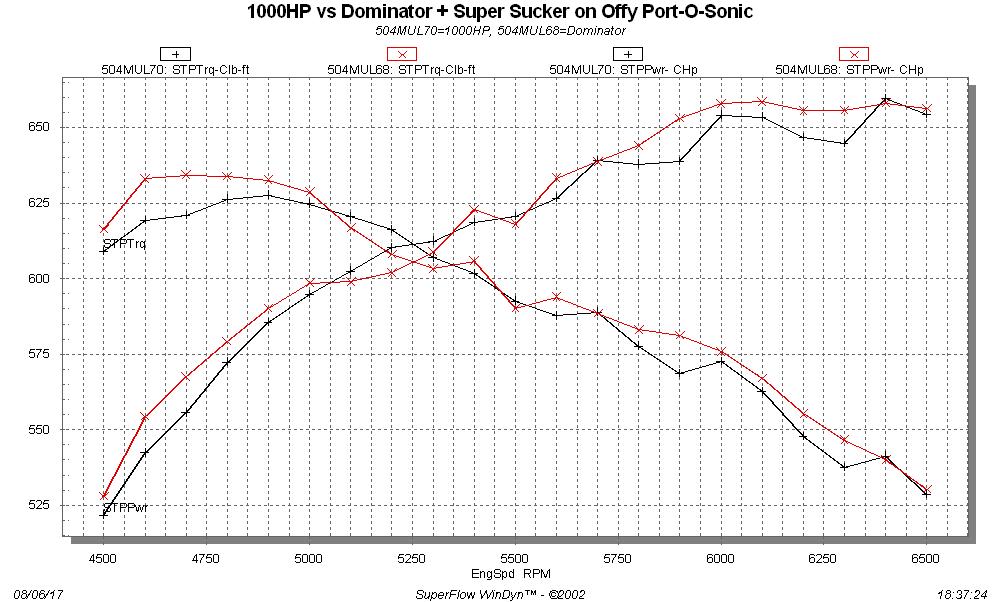
I ran out of time to do any more testing today, but I expect to test the Offy tunnel ram with the single 4 top and the Dominator carb plus Super Sucker sometime this week. Also I should be able to test that Bud Moore boxram intake on Wednesday if everything goes according to plan, a factory Ford D1Zx single plane Dominator intake, the split plenum Torker, and then finish this series of tests with the 3D printed intake. I hope to be able to post all this data by next weekend. For now, here are the results that I have, updated from the table in the previous post:
